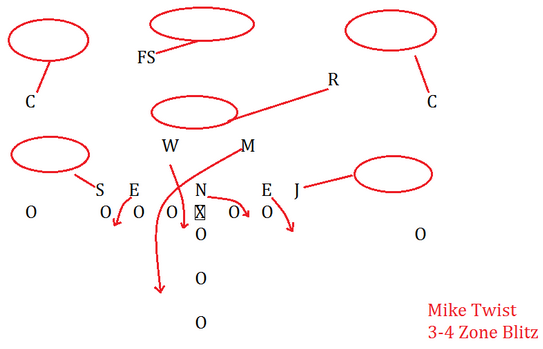Alabama's defense is bigger, faster, and stronger than Virginia Tech's typical opponent, but their front seven doesn't waltz onto the field with the Superman symbol on their chest. I have watched a bunch of film on the Crimson Tide defense over the course of the summer, and while they certainly had moments of physical dominance, they were pushed around up front by several teams. As discussed last week, LSU bullied Alabama's defensive line and linebackers for long stretches, and Georgia was able to get a push on the interior. Texas A&M ran spread and used a ton of play action and misdirection, but in the running game, they attacked the interior gaps. Alabama's defenders can be moved around the box.
Kirby Smart's defense uses movement, gap fits, and assignment execution to create an umbrella across the front and account for each gap. In a base look, the 3-4 is a conservative defense. Players occupy gaps, read and react, and make the play. By nature, it bends.
Alabama turns the tide by using zone blitz concepts. Perhaps no term in football is more misunderstood than a zone blitz. When you watch on TV, and see unblocked linebackers and safeties crushing the quarterback, you might think of the old Buddy Ryan blitzes, where seven or more pass rushers overwhelm the blockers in an attempt to force a quick, inaccurate throw, while outnumbered pass defenders try to play zone or man coverage behind the blitz. Unlike old style blitzing, the zone blitz actually incorporates the blitz concept of outnumbering some blockers at the point of attack to get a clear path to the quarterback, while dropping enough defenders into a typical cover 2 or cover 3 zone. Chris Brown wrote a terrific article on the history of the zone blitz, and I encourage you to read it. The concepts behind the zone blitz are it features SAFE pass coverage, while creating small numerical mismatches between pass rushers and blockers.
The key to an effective zone blitz is taking the 5 pass rushers, and creating a situation where one of the blockers is left without someone to block, while another lineman is forced to make a choice between one of two potential defenders to block. Regardless of which defender the outnumbered blocker picks, he is always wrong and someone will have an unblocked path to the quarterback. Alabama enhances the strategy by using "picks" to enhance those mismatches and create paths to the quarterback. In recruiting, Alabama targets outside linebackers that have the ability to rush the passer off the edge, while their defensive linemen are adept at occupying blockers, which can create lanes for linebackers. Often, the defensive line sacrifices themselves to allow the linebacker to make the play.
Let's examine a typical Alabama zone blitz. First, while the secondary utilizes significant pre-snap motion to disguise the defense, they are playing a conservative 3 deep zone with 3 underneath defenders.

Up front, the goal is to pull the center to the left, which creates a 2 on 1 for the defensive end and mike linebacker against the right guard. The nose stunts hard left, and the center (who has been jammed up by that nose all game long) tends to go with him. The mike and defensive end cross stunt, with the end slanting hard across the guard's face into the center-guard gap, while the mike goes outside the guard. Regardless of who the guard takes, somebody is unblocked.
Even without zone blitzing, the Jack linebacker is often a gifted enough athlete to create pass rush as a straight up edge rusher, as demonstrated by Courtney Upshaw here:
00:01:03–00:01:07
When you take a unique athlete like Upshaw, and add him to a system where the offensive line doesn't know who will blitz, the element of surprise makes the Alabama Jack linebackers even more dangerous.
If you recall from my piece on Bama's linebackers, the inside linebackers often drop back into underneath coverage, where one of the two action as a robber (RAT in Tide terminology.) The RAT plays run first, but when he identifies the pass, he follows the eyes of the quarterback to the ball. Because the RAT isn't necessarily where a linebacker should be in a normal zone, the quarterback can lose him and the RAT can make key interceptions. But, nobody will mistake Alabama's inside linebackers for Brian Urlacher in a zone. They are hammers, and make most of their plays on interior zone blitzes.
In my film review, the most devastating interior zone blitz is a ike twist stunt. The mike twist allows both inside linebackers (who have the shortest distance to the quarterback) to blitz through the interior gaps, while the outside linebackers, corners, and safeties run a very conservative 3 deep zone with 3 underneath zone defenders.

If you look at the 3-4 alignment, a five man rush should be easy to pick up. Center gets the nose. The tackles get the ends. You have two guards and both running backs to account for the two middle linebackers. Movement and timing are utilized to perfection to cause the guards to "lose" the linebackers while delaying long enough for the running backs to clear, yet still in time to destroy the quarterback.
On this version of the interior twists, the nose tackle stunts hard back to the weak side, pulling the center to his right. The nose then draws the center, while setting a pick on the right guard. The Willy linebacker shoots through the center, left guard gap, pulling the left guard inside. The Mike linebacker crosses behind the Willy, and attacks the space vacated by the left guard, who is essentially being "blocked" by the Willy. The delay is brief, but long enough for the backs to vacate, and the Mike linebacker has a clear path to Tyler Bray, which has devastating results.
00:01:09–00:01:14
The Hokies are fortunate, because Bud Foster utilizes some of these same concepts for many of his blitz designs for the 4-4 and 4-2-5 looks. Stopping the zone blitz requires offensive line communication, mobility, the quarterback to identify where the pressure is coming from, and then identify the soft spot in the defense where a defender has to rotate to into the vacated space of the blitzing player. Logan Thomas will be challenged not only physically, but also mentally to identify the defense and make the appropriate sight adjustments, and the wide receiver corps must make themselves available for hot reads when they recognize a blitz.
First and foremost, an effective running game limits the ability to run these designer blitzes. Down and distance will be critical. If the Hokies face a large number of 2-and-10's instead of 2-and-6's, it allows Kirby Smart to play percentages and aggressively blitz while protecting against the big play. That, fellow Hokies, is a recipe for disaster.


Comments
Please join The Key Players Club to read or post comments.
Please join The Key Players Club to read or post comments.
Please join The Key Players Club to read or post comments.
Please join The Key Players Club to read or post comments.
Please join The Key Players Club to read or post comments.
Please join The Key Players Club to read or post comments.
Please join The Key Players Club to read or post comments.
Please join The Key Players Club to read or post comments.
Please join The Key Players Club to read or post comments.